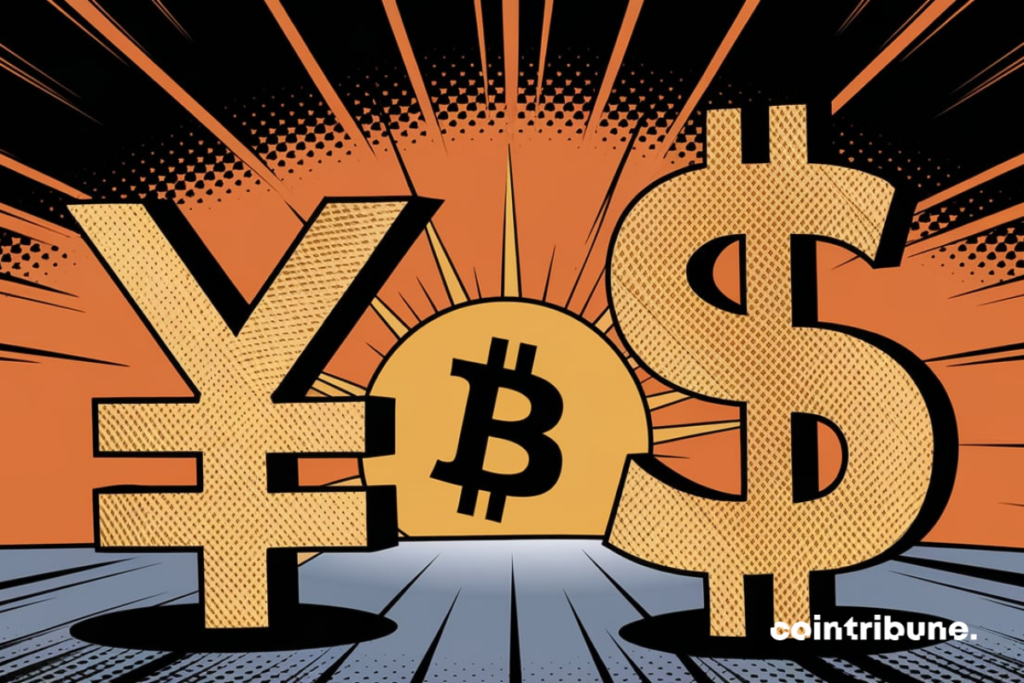🇨🇳 China’s holding of US treasuries thru time via @opinion pic.twitter.com/q9CJI64Osp
— Peter Morgan (@psimpsonmorgan) July 7, 2024
A
A
The Internationalization of the Yuan is Striking
Mon 26 Aug 2024 ▪
6
min read ▪ by
Getting informed
▪
Payment
The internationalization of the yuan is progressing much faster than what the figures from the company Swift suggest. Bitcoin in ambush.

The decline of the Swift network
The company Swift dominates most international banking transactions. More than 11,000 financial institutions in over 200 countries and territories use its services.
It is responsible for the standardization that underpins international financial messaging. Both private banks and central banks, as well as financial markets, use its messaging system to conduct their transactions.
The yuan is currently the fourth most used currency through the Swift network (Society for Worldwide Interbank Financial Telecommunication). Its share has remained above 4% for the ninth consecutive month (4.75%). To be compared with the 7% of the British pound, the 22.50% of the euro, and the 47.80% of the United States.
Its share is 3.32% concerning international payments only. It is 12.80% for the euro (excluding payments between eurozone countries) and 59.46% for the dollar.
In short, figures that are hardly impressive. Nevertheless, the Swift network is no longer a monopoly! The militarization of the Swift network, the euro, and the dollar against Russia has caused a cold reaction from the BRICS. Many countries are reverting to their own currencies while turning to new international payment systems.
The use of the yuan has been on the rise since Russia was disconnected from the Swift network. Sino-Russian trade (~$240 billion per year) now takes place almost exclusively in yuan or rubles.
The internationalization of the yuan is a reality. Let’s remember that Xi Jinping has publicly invited Gulf countries to sell their oil in yuan through the Shanghai market. Knowing that Saudi Arabia, Iran, and the United Arab Emirates have just joined the BRICS…
The continuous decline of Chinese dollar reserves is a sign that doesn’t lie:
The Chinese equivalent of the Swift network
The transaction volume of the Chinese cross-border payment system CIPS was 123 trillion yuan in 2023 ($17 trillion). This represents a year-on-year increase of 27%.
This figure is expected to double this year, equivalent to $34 trillion. To be compared with the $150 trillion traded through the Swift network.
The CIPS system now has 150 direct participants and 1,401 indirect participants. They are spread across 117 countries and regions and can cover up to 184 countries and regions through more than 4,700 banks.
In short, the yuan’s share in global exchanges is well above 4.75%. It is actually much closer to 20%. No surprise when you consider that China’s share in global trade is around 17%. Not to mention that China’s GDP surpasses that of the United States (at purchasing power parity).
CIPS is gaining ground thanks to bilateral currency swaps. Forty-four countries have benefited from these swaps amounting to more than $500 billion. Therefore, more than 53% of China’s trade is now conducted in yuan. The dollar’s share has fallen to 43%, compared to 83% in 2010.
Even the IMF has recently noted that the use of the yuan in cross-border payments has increased from 0% in 2014 to 20% in 2021 (based on a sample of 125 countries). A quarter of these countries predominantly use the yuan to trade with China.
And Bitcoin?
There is no suggestion that the Chinese government is changing its stance on Bitcoin. That said, Hong Kong Bitcoin ETFs have appeared. A good sign.
Its great Russian ally is moving faster. The Duma and the Russian central bank have just authorized two platforms that will allow companies to conduct cross-border transactions in Bitcoin. The framework remains “experimental,” but we can bet that the success will be resounding.
This service will initially be limited to large exporting and importing companies. By the way, several media outlets have falsely talked about stablecoins backed by the ruble and the yuan. It also does not appear that this experimental framework concerns CBDCs.
First scared, governments are realizing that Bitcoin is not a threat and that the world has never gone backward after a technological breakthrough. Bitcoin is a universal payment network that is also a currency existing in an absolutely finite quantity, two-in-one. There will be no turning back.
Even the United States is beginning to recognize that it will sooner or later become the international reserve currency par excellence. Donald Trump has already announced the creation of a strategic Bitcoin reserve in case of re-election. We are potentially talking about a reserve of 1 million BTC!
Trump knows that the process of dedollarization is irreversible. The BRICS will not turn back. The world needs a stateless, non-censorable currency that grants no privilege to any particular nation.
It’s time for the United States to trade on equal terms and for geopolitical tensions to cease before it’s too late. Don’t miss our article on this subject: Russia pleads in New York for the end of the dollar monopoly.
Maximize your Cointribune experience with our "Read to Earn" program! For every article you read, earn points and access exclusive rewards. Sign up now and start earning benefits.
A
A
Bitcoin, geopolitical, economic and energy journalist.
DISCLAIMER
The views, thoughts, and opinions expressed in this article belong solely to the author, and should not be taken as investment advice. Do your own research before taking any investment decisions.